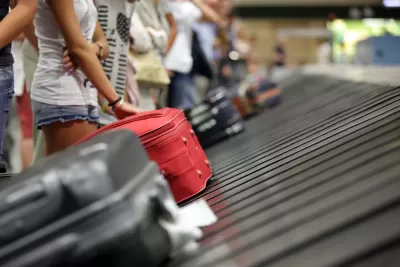In another pandemic reversal, a "safe country" list was completed by EU officials to take effect July 1 to prevent the reintroduction of the coronavirus. President Trump banned travelers from Europe in March to reduce the introduction of the virus.

"The list of safe countries was completed by E.U. senior diplomats in Brussels after tortuous negotiations on how to reopen the 27-member bloc to commerce and tourism under a common set of standards after months of lockdown," reports Matina Stevis-Gridneff, Brussels correspondent for The New York Times on June 26. The list awaits approval from the 27 nations before taking effect July 1, Wednesday.
The exclusion of the United States, an important source of tourism to the European Union, represented a stinging rebuke to the Trump administration’s management of the coronavirus scourge.
Countries that made the safe list, which include Canada and Australia, were judged on a mix of scientific criteria that included their infection rates and the credibility of their public health reporting data. The list will be updated every two weeks, raising the possibility that excluded countries will be added.
Tables turned
The proposed ban is eerily similar to the new Tri-State Travel Advisory by New York, New Jersey and Connecticut, the region that was the first epicenter of the pandemic in the U.S. and has since brought their infection rates down. On March 23, Florida Gov. Ron DeSantis has issued an executive order mandating a 14-day self-quarantine or isolation period for travelers coming from the Tri-State region, as reported by CNN.
On Saturday, Florida reported the most COVID-19 cases in the U.S., over 9,600, among the nation's 44,782 new cases, "the second day in a row that new cases have risen above 40,000 and the fifth consecutive day setting a single-day record for cases," according to The Washington Post.
While President Trump had proposed quarantining the Tri-State region, he backed off, unlike the proclamations he issued on March 11 and March 14 suspending travel from Europe and the UK, respectively, to prevent the spread of the virus, that are still in effect though exceptions are made. Europe, on the other hand, has largely succeeded in bringing infections down to manageable levels.
Similar to the Tri-State travel advisory, the European Union is using scientific criteria, unlike Gov. DeSantis and President Trump who targeted specific states and countries, respectively, without citing health metrics, as Francis Prose, an American novelist, opined in The Guardian on June 26, "How did America become a pariah nation of super-spreaders?"
It’s not a matter of politics, not a retaliation for the fact that Donald Trump has banned travelers from Europe from entering the United States, but a more commonsense scientific decision based solely on criteria having to do with health: America has done such a poor job of controlling the Covid-19 outbreak that our infection rate is increasing dramatically while that of most European nations (and others such as Cuba, China and Vietnam) is either remaining stable or decreasing. We’re simply too dangerous – too likely to bring the deadly virus along with the more welcome (and needed) tourist dollars.
European wall?
The tables are turned in another way. To some extent, Europe is doing to the U.S. what the U.S. is doing to Mexico and Central America – it has built a virtual wall to prevent Americans from entering their side of the pond. But unlike Trump's wall, which aims to protect America from rising racial diversity, this one is based on public health criteria that the U.S. fails to meet for reasons explained by Prose above.
The criteria
"Countries on the E.U. draft lists have been selected as safe based on a combination of epidemiological criteria," reported Stevis-Gridneff on June 23.
The benchmark is the E.U. average number of new infections — over the past 14 days — per 100,000 people, which is currently 16 for the bloc. The comparable number for the United States is 107, while Brazil’s is 190 and Russia’s is 80, according to a Times database.
Related in Planetizen:
-
Pandemic Reversal: The New Tri-State Quarantine, June 25, 2020
FULL STORY: E.U. Plans to Bar Most U.S. Travelers When Bloc Reopens

Alabama: Trump Terminates Settlements for Black Communities Harmed By Raw Sewage
Trump deemed the landmark civil rights agreement “illegal DEI and environmental justice policy.”

Planetizen Federal Action Tracker
A weekly monitor of how Trump’s orders and actions are impacting planners and planning in America.

The 120 Year Old Tiny Home Villages That Sheltered San Francisco’s Earthquake Refugees
More than a century ago, San Francisco mobilized to house thousands of residents displaced by the 1906 earthquake. Could their strategy offer a model for the present?

Ken Jennings Launches Transit Web Series
The Jeopardy champ wants you to ride public transit.

BLM To Rescind Public Lands Rule
The change will downgrade conservation, once again putting federal land at risk for mining and other extractive uses.

Indy Neighborhood Group Builds Temporary Multi-Use Path
Community members, aided in part by funding from the city, repurposed a vehicle lane to create a protected bike and pedestrian path for the summer season.
Urban Design for Planners 1: Software Tools
This six-course series explores essential urban design concepts using open source software and equips planners with the tools they need to participate fully in the urban design process.
Planning for Universal Design
Learn the tools for implementing Universal Design in planning regulations.
Clanton & Associates, Inc.
Jessamine County Fiscal Court
Institute for Housing and Urban Development Studies (IHS)
City of Grandview
Harvard GSD Executive Education
Toledo-Lucas County Plan Commissions
Salt Lake City
NYU Wagner Graduate School of Public Service





























